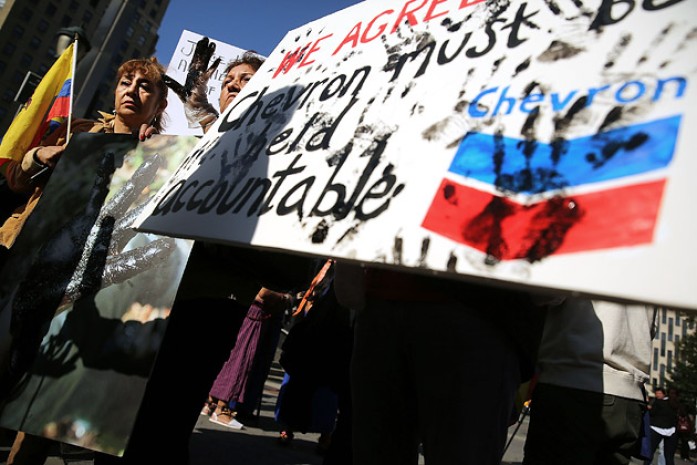
Bloomberg Businessweek 23/01/2017

Photographer: Spencer Platt/Getty Images via Bloomberg Businessweek
Now entering its 24th year, an international legal war seeking to hold Chevron Corp. liable for oil pollution in the Amazon has featured battles in courtrooms ranging from the U.S. to Ecuador to Canada. In a blow to Ecuadorian villagers who contend the company sullied their lands, an Ontario judge last week protected Chevron’s Canadian assets from being seized as part of the fight.
That’s a big victory for the second-largest U.S. fossil fuel company, because in 2011 Chevron lost a court case in Ecuador over the question of liability. As far as the Ecuadorian judiciary is concerned, Chevron owes some $9.5 billion, plus interest, to the villagers. But the energy giant, contending that the enormous judgment was obtained by fraud, has refused to pay. Chevron has no assets in Ecuador, so there’s nothing there for plaintiffs to seize. That’s why the case migrated north to Canada, where a subsidiary has operations the villagers would like to liquidate to cover their verdict.
But in a highly technical 35-page opinion, Judge Glenn Hainey of the Ontario Superior Court of Justice made a sharp distinction between Chevron the parent corporation and Chevron Canada the subsidiary. Chevron Canada wasn’t the defendant in Ecuador and as a legally separate entity, the judge held, can’t be held responsible for its parent’s liabilities.
Chevron hailed the decision. “Once again, the plaintiffs’ attempts to enforce their fraudulent judgment have been rebuked,” R. Hewitt Pate, Chevron’s vice president and general counsel, said via email. “We are confident that any jurisdiction that examines the facts of this case and the misconduct committed by the plaintiffs will find the Ecuadorian judgment illegitimate and unenforceable.”
Karen Hinton, a New York-based spokesperson for the villagers, said in a statement that her clients will appeal Hainey’s ruling, and predicted a swift reversal. “The villagers expect to proceed later this year with their seizure of Chevron’s assets to force the company to respect multiple [Ecuadorian] court judgments that found it” liable for massive contamination, Hinton added.
The very long story that brings us to this moment began in 1993 with a lawsuit filed in New York federal court against Texaco (which Chevron acquired in 2001). Brought on behalf of poor rural Ecuadorians, the complaint was dismissed by U.S. courts and restarted in 2003 in Ecuador. Eight years later, it led to the multibillion-dollar verdict now at issue. Chevron countered that any pollution resulting from Texaco’s activities in the rain forest was the responsibility of the Ecuadorian government to clean up—and, in any event, the verdict was tainted by the misconduct of the villagers lawyers, led by a New York-based attorney named Steven Donziger.
To drive home that last point, Chevron sued Donziger in 2011, obtaining a U.S. judgment that he’d violated anti-racketeering laws by turning the Ecuadorian suit into the equivalent of an extortion scheme. Last year, a federal appeals court upheld the ruling, finding that Donziger and his colleagues engaged in coercion, fraud, and bribery in Ecuador. The decisions have the effect of making it impossible for the villagers to collect on the Ecuadorian verdict in the U.S. That brings us to Canada.
The legal complexities in this branch of the litigation proliferate. In a separate part of his Jan. 20 ruling, Judge Hainey said that if somehow the Ecuadorians succeed in moving forward with their action in Canada—for example, if a higher court reversed his finding that the subsidiary should be shielded—then the oil company would be allowed to fight asset seizures by pointing to the evidence of fraud presented in the U.S. racketeering case.
Meanwhile, on other fronts, the plaintiffs have started legal proceedings to enforce the controversial Ecuadorian judgment in both Argentina and Brazil. Chevron may have won this battle, but the legal war shows no sign of letting up.
Fuente OriginalNotas relacionadas